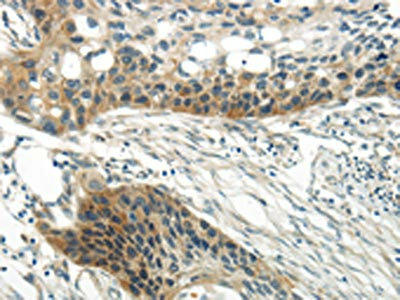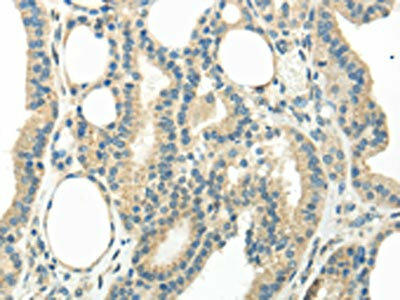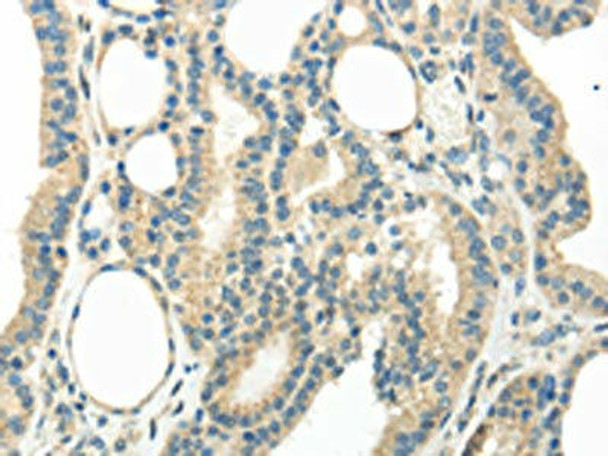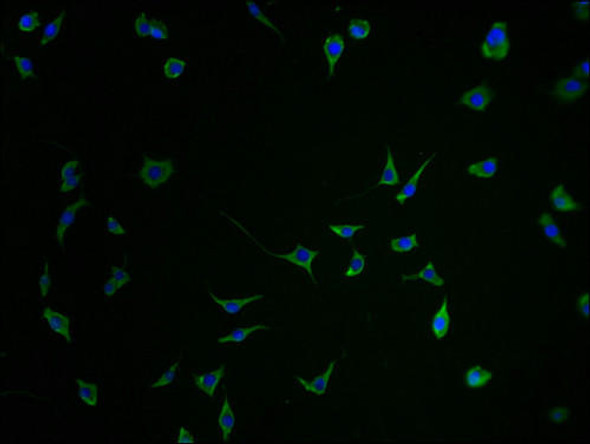Description
WNT6 Antibody (PACO20918)
The Wnt6 Antibody (PAC020918) is a polyclonal antibody designed for research involving the Wnt6 protein, a member of the Wnt signaling pathway known for its role in cell proliferation, differentiation, and migration. The antibody, raised in rabbits, has high reactivity with human samples and is validated for use in various applications including Western blotting and immunofluorescence.The Wnt6 protein is a key player in developmental processes and tissue homeostasis, making it a valuable target for studies in stem cell research, regeneration, and cancer biology. By binding to the Wnt6 protein, this antibody enables researchers to detect and analyze its expression levels in different cell types, providing valuable insights into the role of Wnt6 in various biological processes.
Understanding the function of Wnt6 is essential for advancing research in developmental biology, regenerative medicine, and cancer therapeutics. With its specificity and reliability, the Wnt6 Antibody (PAC020918) is a valuable tool for scientists investigating the intricate mechanisms of the Wnt signaling pathway and its implications in health and disease.
| Antibody Name: | WNT6 Antibody (PACO20918) |
| Antibody SKU: | PACO20918 |
| Size: | 50ul |
| Host Species: | Rabbit |
| Tested Applications: | ELISA, IHC |
| Recommended Dilutions: | ELISA:1:2000-1:5000, IHC:1:25-1:100 |
| Species Reactivity: | Human, Mouse |
| Immunogen: | Synthetic peptide of human WNT6 |
| Form: | Liquid |
| Storage Buffer: | -20°C, pH7.4 PBS, 0.05% NaN3, 40% Glycerol |
| Purification Method: | Antigen affinity purification |
| Clonality: | Polyclonal |
| Isotype: | IgG |
| Conjugate: | Non-conjugated |
 | The image on the left is immunohistochemistry of paraffin-embedded Human esophagus cancer tissue using PACO20918(WNT6 Antibody) at dilution 1/35, on the right is treated with synthetic peptide. (Original magnification: x200). |
 | The image on the left is immunohistochemistry of paraffin-embedded Human thyroid cancer tissue using PACO20918(WNT6 Antibody) at dilution 1/35, on the right is treated with synthetic peptide. (Original magnification: x200). |
| Background: | The WNT gene family consists of structurally related genes which encode secreted signaling proteins. These proteins have been implicated in oncogenesis and in several developmental processes, including regulation of cell fate and patterning during embryogenesis. This gene is a member of the WNT gene family. It is overexpressed in cervical cancer cell line and strongly coexpressed with another family member, WNT10A, in colorectal cancer cell line. The gene overexpression may play key roles in carcinogenesis. This gene and the WNT10A gene are clustered in the chromosome 2q35 region. The protein encoded by this gene is 97% identical to the mouse Wnt6 protein at the amino acid, level. |
| Synonyms: | wingless-type MMTV integration site family, member 6 |
| UniProt Protein Function: | WNT6: Ligand for members of the frizzled family of seven transmembrane receptors. Probable developmental protein. May be a signaling molecule which affects the development of discrete regions of tissues. Is likely to signal over only few cell diameters. Belongs to the Wnt family. |
| UniProt Protein Details: | Protein type:Secreted; Extracellular matrix; Cell development/differentiation; Secreted, signal peptide Chromosomal Location of Human Ortholog: 2q35 Cellular Component: endoplasmic reticulum lumen; extracellular region; extracellular space; Golgi lumen; plasma membrane Molecular Function:frizzled binding Biological Process: cell fate commitment; neuron differentiation; odontogenesis of dentine-containing teeth; Wnt receptor signaling pathway |
| NCBI Summary: | The WNT gene family consists of structurally related genes which encode secreted signaling proteins. These proteins have been implicated in oncogenesis and in several developmental processes, including regulation of cell fate and patterning during embryogenesis. This gene is a member of the WNT gene family. It is overexpressed in cervical cancer cell line and strongly coexpressed with another family member, WNT10A, in colorectal cancer cell line. The gene overexpression may play key roles in carcinogenesis. This gene and the WNT10A gene are clustered in the chromosome 2q35 region. The protein encoded by this gene is 97% identical to the mouse Wnt6 protein at the amino acid level. [provided by RefSeq, Jul 2008] |
| UniProt Code: | Q9Y6F9 |
| NCBI GenInfo Identifier: | 14424016 |
| NCBI Gene ID: | 7475 |
| NCBI Accession: | Q9Y6F9.2 |
| UniProt Secondary Accession: | Q9Y6F9,Q9H1J6, Q9H238, |
| UniProt Related Accession: | Q9Y6F9 |
| Molecular Weight: | 39,721 Da |
| NCBI Full Name: | Protein Wnt-6 |
| NCBI Synonym Full Names: | Wnt family member 6 |
| NCBI Official Symbol: | WNT6 |
| NCBI Protein Information: | protein Wnt-6 |
| UniProt Protein Name: | Protein Wnt-6 |
| Protein Family: | Protein |
| UniProt Gene Name: | WNT6 |
| UniProt Entry Name: | WNT6_HUMAN |













